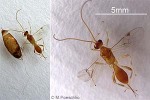Cook Islands Biodiversity Database
Species Page
Meteorus pulchricornis
Multimedia & Additional Resources
| Type | Description | Download |
| Adult female and pupa case | 38KB |
General Information
Cook Islands Distribution
| Southern Group: Present Makatea: | ||||||||
RR |
MG |
AT |
MK |
MT |
AK |
PL |
TK |
MN |
P |
||||||||
| Northern Group: | |||||
TN |
MH |
RK |
PK |
NS |
SW |
Pests & Hosts
| Relationship | Hosts |
| Parasitoid (biocontrol) of caterpillars | Spodoptera litura, |
Scientific Taxonomy
Meteorus pulchricornis (Wesmael)
TAXONOMY: ANIMALIA; ARTHROPODA; ATELOCERATA; HEXAPODA; INSECTA; PTERYGOTA; Hymenoptera; Apocrita; Parasitica; Ichneumonoidea; BRACONIDAE
More Information
SIGNIFICANCE NOTES -
POSITIVE SIGNIFICANCE: Biocontrol of caterpillars, but may damage native biodiversity also. Comments: See General note by Graham Walker on this wasp.
GENERAL NOTE: Is it a pest? or a beneficial insect? It is an extreme generalist larval parasitoid attacking any exposed lepidopteran larvae. I have reared it out of every lepidopteran species I have collected on vegetable crops in New Zealand except Pieris rapae (white butterfly). On brassicas, it readily attacks Helicoverpa armigera and Spodoptera litura, but I have also reared it from Plutella xylostella (DBM, Diamond-back Moth). From micro Lepidoptera such as DBM, the cocoons are very small which would be a clue for you. Being 5 mm long I would say it probably came out of Spodoptera, not DBM. It attacks small larvae (2nd instar) and emerges from about medium 4th instar stages, not letting the host grow very large.
We only have females in New Zealand (thelytokous) which makes us believe it originated in Asia which has females only, whereas Europe have males and females present (arrhenotokous = biparental). Yours [Maja's image] of course is a female.
We have reared it from about 30 species from 8 families of Lepidoptera in NZ.
Our fear is it is penetrating into native habitats and attacking native fauna and upsetting native parasitoids, etc. [Pestnet email 15/3/2005, Graham Walker, Crop and Food Research, Auckland. Also mentions: NZ Journal of Zoology, 2004 vol. 31: 33-44, paper by Dr Jo Berry and G.Walker.]
Vouchers & References
Vouchers:
Rarotonga: specimens+photo, 3/2005, parasitoid on cabbage pest-caterpillars, Maja Poeschko, with ID G.Walker from photo as Meteorus pulchricornis 3/2005.
References:
None recorded.
Data Update History (information):
zTX, zB05a, zM05a
Web Resources
Citation Information
McCormack, Gerald (2007) Cook Islands Biodiversity Database, Version 2007.2. Cook Islands Natural Heritage Trust, Rarotonga. Online at http://cookislands.bishopmuseum.org. ![]()
Please refer to our use policy.

